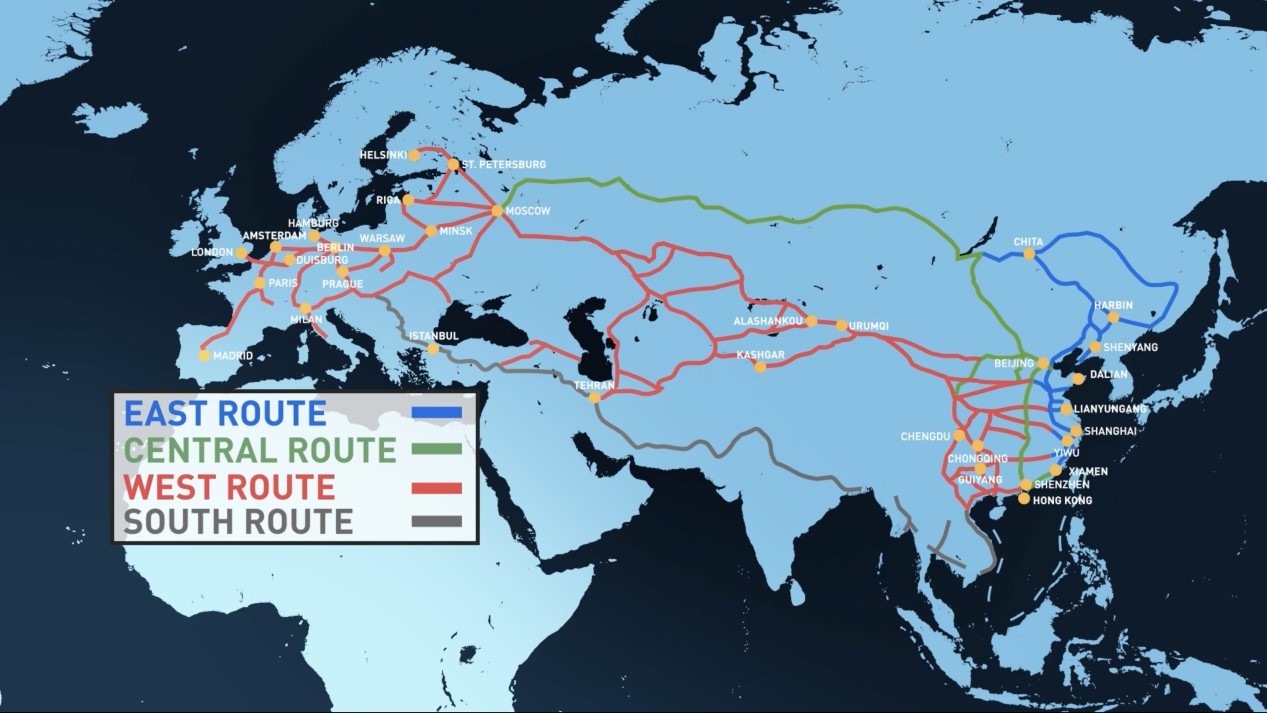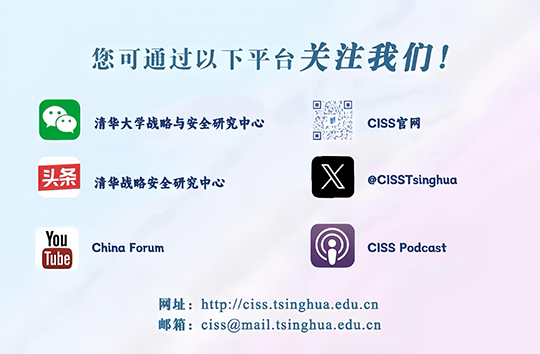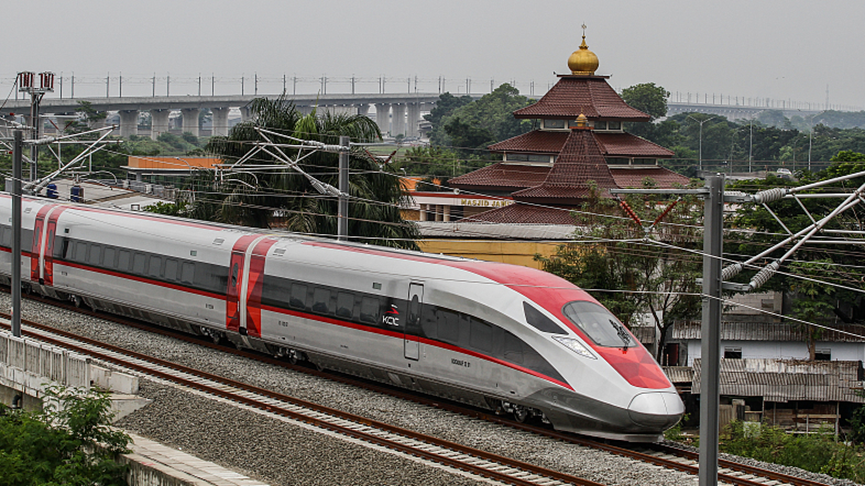2023年是中国提出共建“一带一路”倡议十周年。“一带一路”倡议的根本出发点和落脚点,是探索共同发展的新办法,开拓造福各国、惠及世界的“幸福路”。我国呼吁各国共同致力于建设持久和平、普遍安全、共同繁荣、开放包容、清洁美丽的世界,推动构建人类命运共同体。本期《参考观点》聚焦关于十年来共建“一带一路”杰出表现的评论,供读者参考。1. “一带一路”倡议由中国政府于2013年提出,目前已在70多个国家实施。当全球化在美国和欧洲越来越失去公众支持之际,中国的 “一带一路”倡议没有被地域限制, 反而日渐得到发展中国家以及发达国家的认可。1999年的中国还是国际开发协会 (IDA) 的最大借款国,在经历了20年的高速增长之后,中国已在2019年取代世界银行成为世界上最大的发展金融贷款机构。“一带一路”倡议改变了中国过去过度依赖西方的国际贸易结构,在促进中国经贸结构再平衡的同时,也在推动国际关系格局和全球视野的变化。The initiative is arguably the first concept for global cooperation in the history of China’s 5,000-year-old civilisation that has both global strategic significance and a clear path for implementation. Over the past 10 years, the belt and road has revamped China’s international trade structure, which had previously been overly reliant on the West, and gradually promoted the rebalancing of China’s economic focus. It has also reshaped the world view of the Chinese and fostered a global perspective of openness.In fact, while the belt and road promotes the rebalancing of China’s economic and trade structure, it is also promoting changes to the pattern of international relations and global perspectives.(Oct. 3, 2023, “10 Years of Belt and Road: a Showcase of China’s Peaceful Rise”, South China Morning Post)Until 1999, China was the largest borrower from the International Development Association (IDA), the member of the World Bank Group responsible for lending to the world's poorest countries. Two decades of high growth later, in 2019, China overtook the World Bank as the world's largest lender of development finance. This remarkable change is owed primarily to the Belt and Road Initiative (BRI), a global infrastructure plan conceptualized in China in 2013 and which has been implemented in more than 70 countries. Under the BRI, China works with partner countries to design and implement large infrastructure projects. Such transformative, national-scale investment is naturally attractive to poor countries, and helps explain why they, as well as some rich countries, are willing to turn to the BRI.(July 6, 2020. “Demystifying the Belt and Road Initiative.” Rand Corporation)2. 中国“一带一路”倡议的目标随着国内国际形势的变化,不断扩展合作空间和领域,以适应各行业所涉及的不同市场动态和商业参与者,例如将重点转向数字经济,绿色技术和健康等高科技和知识产业,从而更好帮助发展中国家实现经济发展。“一带一路”与国内优先事项的结合也更加系统化:陆上丝绸之路与新疆的发展和中国西部的全球化紧密相连;海上丝绸之路与粤港澳大湾区战略密切相关。As the BRI approaches ten years of age, its integration with domestic priorities has become more systematic. Among the corridors, the land-based BRI is tightly connected to Xinjiang’s development and western China’s globalization. The sea-based BRI ties closely with the Greater Bay strategy surrounding Hong Kong and the maritime expansion of eastern China. Furthermore, China’s state-owned enterprises (SOEs) are expanding their investment and operation in the green economy, digital infrastructure, construction industries and railways.(Sept. 6, 2022, “Ten Years of the Belt and Road: Reflections and Recent Trends”, Boston University Global Development and Policy Center)Other industrial objectives were gradually added to the mix. The Chinese government’s ‘13th Five-year Plan’, its programme of government for 2016–20, set out new industrial ambitions. As the overseas incarnation of its industrial policy, the BRI soon reflected these new goals. China’s attention turned first to the digital economy, with Beijing adopting the Digital Silk Road (DSR) strand of the initiative in 2015. Subsequently, Beijing trained its sights on other high-tech and knowledge industries, including green technology and health (including e-health and pharmaceuticals). This widening industrial scope has led the BRI to expand and adapt to accommodate the different market dynamics and commercial actors involved in each sector, and Chinese loans and investments in BRI countries have flowed to these different sectors over time.(Nov. 17, 2022, “China's Belt and Road Initiative – Strategy: China's Evolving Ambitions”, International Institute for Strategic Studies, IISS)1. 中国正在扩大对绿色经济、数字基础设施、建筑业和铁路的投资和运营。“一带一路”倡议的内容将不仅停留在铁路和轮船促进大宗货物和集装箱物流的大规模项目,在保持运输基础设施建设的同时,而是转向其他工业设施和科技领域项目,帮助更多发展中国家实现工业化与经济发展。As the Belt and Road Initiative (BRI) enters its second decade, its newest projects are very different from the first wave of deals were – having shifted from massive scale traditional infrastructure undertakings that facilitated bulk and container logistics by rail and ship to more technologically advanced projects that transmit ones and zeroes via fiber optic cables and satellites.Looking at new projects by section, technology’s share is growing but energy and transport projects remain important. For example, in 2022, China Energy Engineering Corporation won the bid for a thermal power plant in Indonesia and PowerChina took on an Indonesian coal mining project. Mining and metals also ranked high in new BRI projects last year, in accordance with Beijing’s policy focus on raw material supplies.(Sept. 27, 2023, “China Inc is Recalibrating its Approach to its Overseas Footprint as the BRI turns 10 years old”, MERICS)2. 商务部表示,今年前八个月,中国对外直接投资持续增长,特别是对“一带一路”共建国家的直接投资增长22.5%至1403.7亿元人民币。我国企业在“一带一路”共建国家承包工程完成营业额5295.2亿元人民币,同比增长4.8%。China's outbound direct investment has continued to grow in the first eight months of this year, especially in economies involved in the Belt and Road Initiative, the Ministry of Commerce said.Investment in BRI economies grows 22.5% to 140b yuan in reporting period.Meanwhile, during the eight months, turnover of China's foreign contracted projects reached 648.62 billion yuan, up 6.1 percent year-on-year. The value of China's newly signed contracts in foreign countries reached 863.34 billion yuan, a year-on-year increase of 2 percent.The turnover of China's foreign contracted projects in the economies involved in the BRI reached 529.52 billion yuan, up 4.8 percent year-on-year. The value of China's newly signed contracts in BRI economies achieved 725.35 billion yuan, up 5.6 percent year-on-year, the ministry said.(Sep 22, 2023. “Nation's ODI further rises in Jan-Aug.” China Daily)
China has initiated the Silk Road Fund, the Asian Infrastructure Investment Bank and other financial institutions and has carried out various forms of cooperation in order to promote the building of a long-term, stable, sustainable, risk controllable and diversified financing system. By the end of 2019, the total value of trade in goods between China and other Belt and Road countries has exceeded 7.8 trillion US dollars with China's investment in these countries over 110 billion US dollars. A batch of cooperation parks jointly built by China and other participating countries are on the run. The interconnecting structure of six corridors, six means of communication, multiple countries and multiple ports has been generally formed with lots of thriving cooperation projects. Infrastructure framework formed by railways, roads, shipping, aviation, pipelines and integrated space information networks is under accelerating construction.(Mar 17, 2020. “Belt and Road Initiative Creates Remarkable Achievements.” China Daily)1. “一带一路”倡议不仅是经济繁荣之路,也是绿色发展之路。绿色丝绸之路的工作与目标包括减少碳排放、减少污染和保护生物多样性。从“一带一路”倡议绿色投资原则,到“一带一路”倡议国际绿色发展联盟,中国在“一带一路”倡议国家能源领域的投资建设中,重点投入太阳能、风能或水电等可再生能源项目,助力各国实现可持续发展。According the report from the Green Finance and Development Centre (GFDC) at Fudan University in Shanghai, 56% of China's $8.61 billion in engagement, which they define as construction and investment, in the energy sector in BRI countries during the first half of the year went into renewable energy such as solar, wind, or hydropower projects. "If we continue at this pace, 2023 would be the year with the largest green energy investment," GFDC Director Christoph Nedopil told Reuters.“Overall, China's BRI engagement seems to become more strategic, in regard to both economic and industrial aspects: more bankable projects relevant for China's and the host countries' industrial development - and luckily many of these projects can be green," Nedopil said.(Aug. 2, 2023, “China's Belt and Road Energy Projects Set for ‘Greenest’ Year, Research Shows”, Reuters)Chinese policymakers have increasingly focused on the sustainable BRI in recent years. The scope of the Green Silk Road includes reducing carbon emissions, cutting pollution and protecting biodiversity, while also ensuring improved economic opportunities for all countries involved.In late 2018, China released the Green Investment Principles (GIP) for the BRI — a set of principles for greener investments in countries and regions participating in the BRI. As of June 2021, 39 large international financial institutions had embraced the GIP. In 2019, the BRI International Green Development Coalition was established to engage in dialogue, exchanges, joint research, capacity building and other activities. It has since attracted more than 150 Chinese and foreign partners from more than 40 countries, and has garnered a positive response and widespread support from the international community.(May 15, 2023, “Green Silk Road Drives Sustainable Development in BRI landscape”, China Daily)2. “一带一路”倡议已成为深受欢迎的国际公共产品和国际合作平台,着力推进健康、绿色、数字、创新丝绸之路建设,为全球经济发展培育了新增长点。中国通过“一带一路”倡议改善各国人民福祉,加强了中国与世界各国的经济联系。“一带一路”倡议不仅惠及中国,沿线国家不同程度地获得了大量投资、基础设施和贷款。这是一个双赢的过程。This was a win-win game where China would have had more interactions, economic interactions with these countries, also through trade eventually but especially at the beginning with investment loans. And this would have also guaranteed the Chinese subcontractor companies to work on these infrastructure projects, export its industrial champions and, through that economic interaction, deepening interaction, have bigger, larger, deeper political heft.(Sept. 9, 2023, “China's Belt and Road initiative is in its 10th year. Has it been a success?”, NPR News)China has made considerable progress in terms of facilitating high-quality development in the Belt and Road Initiative over the past decade, with over three-quarters of the countries and major international organizations joining the initiative, according to the country's top economic regulator. The BRI has become a popular platform offering international public goods, playing a positive role in promoting health, green and digital construction of the Silk Road and fostering new growth points for the world economy.(Mar 17, 2020. “Belt and Road Initiative Creates Remarkable Achievements.” China Daily)China and countries involved in the BRI have built economic and trade cooperation zones, creating more than 400,000 jobs for local people. Under the framework of the BRI, China and countries involved in the BRI have built a wide range of infrastructure projects and projects key to local people's livelihood such as hospitals and schools, which not only promote economic growth and generate jobs but also improve the local people's livelihood.(Mar 17, 2020. “Belt and Road Initiative Creates Remarkable Achievements.” NDRC)当前,全球政治经济形势复杂多变,投资风险与债务风险上升,整体外部环境严峻且不稳定。面对困局与挑战,中国继续坚定为各国建设高质量、可持续、抗风险、价格合理、包容性强的基础设施,开展有助于各国充分利用其资源的合作。“一带一路”倡议依然显示出了韧性和多样性。Chinese officials are determined to learn lessons from early BRI projects to improve future BRI projects – tightening the selection process, making projects more productive; adjusting financial structures, making projects more conservative; and controlling diverse risks, making projects more viable. The only thing not subject to mid-course correction is President Xi Jinping's BRI vision itself, which he has called "a project of the century." Significantly, the BRI has been written into the Party Constitution.China's mid-course corrections focus on recognizing, assessing, managing, and preventing risks, including political uncertainty and deteriorating security conditions, with kidnapping and robbery, armed attacks and terrorist attacks becoming more frequent. It also includes China's heightened sensitivities to local issues, such as cultural differences and indigenous industrialization. BRI officials are admonished to conduct comprehensive risk assessments before "going global" and commencing projects: they must pre-set risk monitoring and control systems to achieve "early detection, early warning, and early prevention.(Oct. 10, 2023, “The Belt and Road at 10: Challenges, Criticisms, Corrections,” CGTN)Despite evolving geopolitical uncertainty and rising domestic challenges, China's Belt and Road Initiative (BRI) has shown resilience and versatility. By placing more importance on the quality of the projects and increasing regionalization and securitization of the initiative, the BRI is adapting to new contexts.(Aug.10, 2022, “China’s Belt and Road Initiative in a Post-Pandemic World”, Hinrich Foundation)








